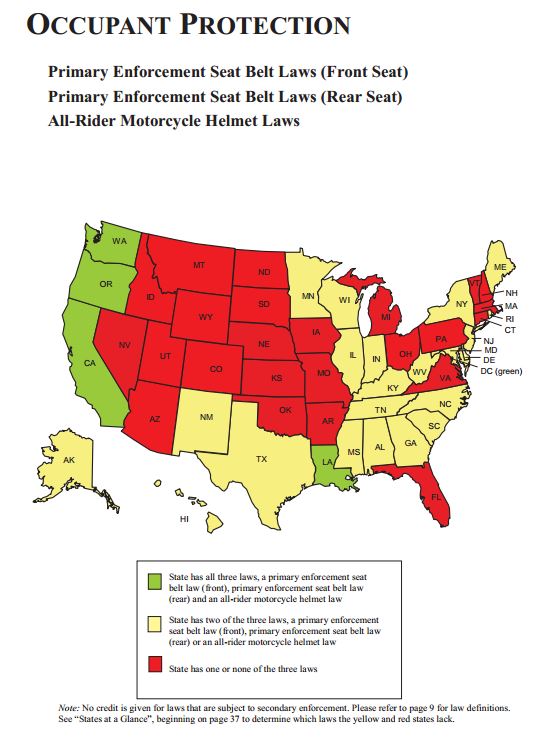A report on highway safety urges state legislatures to examine safety laws and take proactive steps to enact effective rulings. The Advocates for Highway & Auto Safety report “2015 Roadmap of State Highway Safety Laws: Lethal Loopholes,” found that more than 5.6 million crashes in 2013 caused about 32,700 fatalities and 2.3 million injuries. Motor vehicle crashes cost society $871 billion, based on 2010 data.
Federal action and safety requirements can address part of the problem, but state laws have direct impact on promoting safer driver and occupant behavior, according to the report, released in January. An example of the difference state laws can make is with seat belt use, which has been shown to save lives. In 2013, states with primary enforcement seat belt laws for front seat passengers had a 91% belt use rate, while states with secondary enforcement laws had an 80% belt use rate, according to NHTSA data. A study conducted by the Insurance Institute for Highway Safety (IIHS) found that, when states strengthen their laws from secondary to primary enforcement, driver death rates decline by about 7%.
“In 2015, Advocates urges state leaders to close lethal loopholes in their highway safety laws,” Jacqueline S. Gillan, Advocates president, said in the report. “The emotional, economic and societal cost of inaction to improve safety is too high especially considering we know what steps can be taken. Complacency and lack of action have resulted in a dangerous and deadly patchwork of laws across the nation. Lethal loopholes in traffic safety laws are literally killing us—we can and must do better.”
Key facts, according to Advocates:
- 32,719 people were killed in motor vehicle crashes in 2013—a decrease of 3% from 2012. Automobile crashes remain a leading cause of death for Americans between the ages of five and 34.
- About 2.3 million people were injured in motor vehicle crashes in 2013.
- In 2013, almost half (49%) of passenger vehicle occupants killed were unrestrained.
- Crashes involving young drivers (aged 15 – 20) resulted in 4,333 total fatalities in 2013.
- 4,668 motorcyclists died in 2013. Though this is a decrease from 2012, this death toll accounts for 14% of all fatalities.
- 1,149 children age 14 and younger were killed in motor vehicle crashes in 2013.
- 300 children aged four through seven were killed in motor vehicle crashes in 2013.
- More than 3.5 million people have been killed in motor vehicle crashes in the U.S. since 1899.
- The more than 5.6 million police-reported motor vehicle crashes in 2013 had a societal impact in excess of $870 billion. Thirty-two percent of this figure ($277 billion) is economic costs including property and productivity losses, medical and emergency bills and other related costs. Dividing this cost among the total population amounts to a “crash tax” of $897 for every person, every year.
To meet basic safety recommendations, Advocates said states need to adopt 327 new laws:
- 17 states need an optimal primary enforcement seat belt law for front seat passengers.
- 33 states need an optimal primary enforcement seat belt law for rear seat passengers.
- 31 states need an optimal all-rider motorcycle helmet law.
- 19 states need an optimal booster seat law.
- 174 graduated driver licensing laws need to be adopted to ensure the safety of novice drivers; no state meets all the criteria recommended in the report.
- 42 critical impaired driving laws are needed in 39 states and D.C.
- 11 states need an optimal all-driver text messaging restriction.

